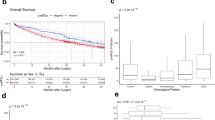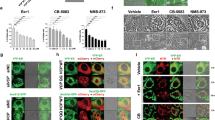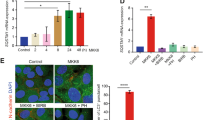Abstract
Oncogene-induced replicative stress activates an Atr- and Chk1-dependent response, which has been proposed to be widespread in tumors. We explored whether the presence of replicative stress could be exploited for the selective elimination of cancer cells. To this end, we evaluated the impact of targeting the replicative stress-response on cancer development. In mice (Mus musculus), the reduced levels of Atr found on a mouse model of the Atr-Seckel syndrome completely prevented the development of Myc-induced lymphomas or pancreatic tumors, both of which showed abundant levels of replicative stress. Moreover, Chk1 inhibitors were highly effective in killing Myc-driven lymphomas. By contrast, pancreatic adenocarcinomas initiated by K-RasG12V showed no detectable evidence of replicative stress and were nonresponsive to this therapy. Besides its impact on cancer, Myc overexpression aggravated the phenotypes of Atr-Seckel mice, revealing that oncogenes can modulate the severity of replicative stress-associated diseases.
This is a preview of subscription content, access via your institution
Access options
Subscribe to this journal
Receive 12 print issues and online access
$189.00 per year
only $15.75 per issue
Buy this article
- Purchase on Springer Link
- Instant access to full article PDF
Prices may be subject to local taxes which are calculated during checkout





Similar content being viewed by others
References
de Bono, J.S. & Ashworth, A. Translating cancer research into targeted therapeutics. Nature 467, 543–549 (2010).
Bryant, H.E. et al. Specific killing of BRCA2-deficient tumours with inhibitors of poly(ADP-ribose) polymerase. Nature 434, 913–917 (2005).
Farmer, H. et al. Targeting the DNA repair defect in BRCA mutant cells as a therapeutic strategy. Nature 434, 917–921 (2005).
Luo, J., Solimini, N.L. & Elledge, S.J. Principles of cancer therapy: oncogene and non-oncogene addiction. Cell 136, 823–837 (2009).
Raj, L. et al. Selective killing of cancer cells by a small molecule targeting the stress response to ROS. Nature 475, 231–234 (2011).
Halazonetis, T.D., Gorgoulis, V.G. & Bartek, J. An oncogene-induced DNA damage model for cancer development. Science 319, 1352–1355 (2008).
Bartkova, J. et al. DNA damage response as a candidate anti-cancer barrier in early human tumorigenesis. Nature 434, 864–870 (2005).
Gorgoulis, V.G. et al. Activation of the DNA damage checkpoint and genomic instability in human precancerous lesions. Nature 434, 907–913 (2005).
Bartkova, J. et al. Oncogene-induced senescence is part of the tumorigenesis barrier imposed by DNA damage checkpoints. Nature 444, 633–637 (2006).
Di Micco, R. et al. Oncogene-induced senescence is a DNA damage response triggered by DNA hyper-replication. Nature 444, 638–642 (2006).
Dereli-Öz, A., Versini, G. & Halazonetis, T.D. Studies of genomic copy number changes in human cancers reveal signatures of DNA replication stress. Mol. Oncol. 5, 308–314 (2011).
Cimprich, K.A. & Cortez, D. ATR: an essential regulator of genome integrity. Nat. Rev. Mol. Cell Biol. 9, 616–627 (2008).
López-Contreras, A.J. & Fernandez-Capetillo, O. The ATR barrier to replication-born DNA damage. DNA Repair (Amst.) 9, 1249–1255 (2010).
Harris, A.W. et al. The E mu-myc transgenic mouse. A model for high-incidence spontaneous lymphoma and leukemia of early B cells. J. Exp. Med. 167, 353–371 (1988).
Gorrini, C. et al. Tip60 is a haplo-insufficient tumour suppressor required for an oncogene-induced DNA damage response. Nature 448, 1063–1067 (2007).
Reimann, M. et al. The Myc-evoked DNA damage response accounts for treatment resistance in primary lymphomas in vivo. Blood 110, 2996–3004 (2007).
Shreeram, S. et al. Regulation of ATM/p53-dependent suppression of myc-induced lymphomas by Wip1 phosphatase. J. Exp. Med. 203, 2793–2799 (2006).
Campaner, S. et al. Cdk2 suppresses cellular senescence induced by the c-myc oncogene. Nat. Cell Biol. 12, 54–59 (2010).
Murga, M. et al. A mouse model of ATR-Seckel shows embryonic replicative stress and accelerated aging. Nat. Genet. 41, 891–898 (2009).
Jacks, T. et al. Tumor spectrum analysis in p53-mutant mice. Curr. Biol. 4, 1–7 (1994).
Vafa, O. et al. c-Myc can induce DNA damage, increase reactive oxygen species, and mitigate p53 function: a mechanism for oncogene-induced genetic instability. Mol. Cell 9, 1031–1044 (2002).
Gagou, M.E., Zuazua-Villar, P. & Meuth, M. Enhanced H2AX phosphorylation, DNA replication fork arrest, and cell death in the absence of Chk1. Mol. Biol. Cell 21, 739–752 (2010).
Syljuåsen, R.G. et al. Inhibition of human Chk1 causes increased initiation of DNA replication, phosphorylation of ATR targets, and DNA breakage. Mol. Cell. Biol. 25, 3553–3562 (2005).
Toledo, L.I. et al. A cell-based screen identifies ATR inhibitors with synthetic lethal properties for cancer associated mutations. Nat. Struct. Mol. Biol. 18, 721–727 (2011).
Murphy, D.J. et al. Distinct thresholds govern Myc's biological output in vivo. Cancer Cell 14, 447–457 (2008).
Schmitt, C.A. et al. A senescence program controlled by p53 and p16INK4a contributes to the outcome of cancer therapy. Cell 109, 335–346 (2002).
Spruck, C.H., Won, K.A. & Reed, S.I. Deregulated cyclin E induces chromosome instability. Nature 401, 297–300 (1999).
Gilad, O. et al. Combining ATR suppression with oncogenic Ras synergistically increases genomic instability, causing synthetic lethality or tumorigenesis in a dosage-dependent manner. Cancer Res. 70, 9693–9702 (2010).
Guerra, C. et al. Tumor induction by an endogenous K-ras oncogene is highly dependent on cellular context. Cancer Cell 4, 111–120 (2003).
Jackson, E.L. et al. Analysis of lung tumor initiation and progression using conditional expression of oncogenic K-ras. Genes Dev. 15, 3243–3248 (2001).
Sandgren, E.P., Quaife, C.J., Paulovich, A.G., Palmiter, R.D. & Brinster, R.L. Pancreatic tumor pathogenesis reflects the causative genetic lesion. Proc. Natl. Acad. Sci. USA 88, 93–97 (1991).
Guerra, C. et al. Chronic pancreatitis is essential for induction of pancreatic ductal adenocarcinoma by K-Ras oncogenes in adult mice. Cancer Cell 11, 291–302 (2007).
Efeyan, A. et al. Limited role of murine ATM in oncogene-induced senescence and p53-dependent tumor suppression. PLoS ONE 4, e5475 (2009).
Junttila, M.R. et al. Selective activation of p53-mediated tumour suppression in high-grade tumours. Nature 468, 567–571 (2010).
Olive, K.P. et al. Inhibition of Hedgehog signaling enhances delivery of chemotherapy in a mouse model of pancreatic cancer. Science 324, 1457–1461 (2009).
Hanada, K. et al. The structure-specific endonuclease Mus81 contributes to replication restart by generating double-strand DNA breaks. Nat. Struct. Mol. Biol. 14, 1096–1104 (2007).
Cole, K.A. et al. RNAi screen of the protein kinome identifies checkpoint kinase 1 (CHK1) as a therapeutic target in neuroblastoma. Proc. Natl. Acad. Sci. USA 108, 3336–3341 (2011).
Toledo, L.I., Murga, M. & Fernandez-Capetillo, O. Targeting ATR and Chk1 kinases for cancer treatment: A new model for new (and old) drugs. Mol. Oncol. 5, 368–373 (2011).
Druker, B.J. et al. Effects of a selective inhibitor of the Abl tyrosine kinase on the growth of Bcr-Abl positive cells. Nat. Med. 2, 561–566 (1996).
Fong, P.C. et al. Inhibition of poly(ADP-ribose) polymerase in tumors from BRCA mutation carriers. N. Engl. J. Med. 361, 123–134 (2009).
Hartwell, L.H., Szankasi, P., Roberts, C.J., Murray, A.W. & Friend, S.H. Integrating genetic approaches into the discovery of anticancer drugs. Science 278, 1064–1068 (1997).
Herold, S., Herkert, B. & Eilers, M. Facilitating replication under stress: an oncogenic function of MYC? Nat. Rev. Cancer 9, 441–444 (2009).
Pickering, M.T., Stadler, B.M. & Kowalik, T.F. miR-17 and miR-20a temper an E2F1-induced G1 checkpoint to regulate cell cycle progression. Oncogene 28, 140–145 (2009).
Dominguez-Sola, D. et al. Non-transcriptional control of DNA replication by c-Myc. Nature 448, 445–451 (2007).
Jacome, A. & Fernandez-Capetillo, O. Lac operator repeats generate a traceable fragile site in mammalian cells. EMBO Rep. 12, 1032–1038 (2011).
Robinson, K., Asawachaicharn, N., Galloway, D.A. & Grandori, C. c-Myc accelerates S-phase and requires WRN to avoid replication stress. PLoS ONE 4, e5951 (2009).
Herold, S. et al. Miz1 and HectH9 regulate the stability of the checkpoint protein, TopBP1. EMBO J. 27, 2851–2861 (2008).
Liu, Y.C. et al. Global regulation of nucleotide biosynthetic genes by c-Myc. PLoS ONE 3, e2722 (2008).
Gordan, J.D., Bertout, J.A., Hu, C.J., Diehl, J.A. & Simon, M.C. HIF-2alpha promotes hypoxic cell proliferation by enhancing c-myc transcriptional activity. Cancer Cell 11, 335–347 (2007).
Acknowledgements
We thank M. Serrano for critical comments on the manuscript and F.X. Real for advice on the Ela-myc model. M.M. is supported a grant from Fondo de Investigaciones Sanitarias (PI080220). T.S. is supported by German Research Foundation (DFG) Research Fellowship (SCHL 1945/1-1). Work in O.F.-C.'s laboratory is supported by grants from the Spanish Ministry of Science (CSD2007-00017 and SAF2008-01596), Miguel Catalan Award from the Community of Madrid, European Molecular Biology Organization (EMBO) Young Investigator Programme and the European Research Council (ERC-210520).
Author information
Authors and Affiliations
Contributions
O.F.-C. designed the study and experiments and wrote the paper. M.M. conducted most of the experiments presented. A.J.L.-C. conducted the work with the xenografts and the R26-MERT2 system. L.I.T. helped with the MycER experiments. L.D., T.S., S.C. and B.A. conducted lymphoma chemotherapy and contributed to the discussion of the manuscript. M.F.M. and R.S. analyzed Seckel MEFs, embryos and tumors. C.G. and M.B. worked on K-RasG12V-induced pancreatic tumors. E.G. and M.H. helped to design and worked with xenograft models.
Corresponding authors
Ethics declarations
Competing interests
The authors declare no competing financial interests.
Supplementary information
Supplementary Text and Figures
Supplementary Figures 1–11 (PDF 1507 kb)
Rights and permissions
About this article
Cite this article
Murga, M., Campaner, S., Lopez-Contreras, A. et al. Exploiting oncogene-induced replicative stress for the selective killing of Myc-driven tumors. Nat Struct Mol Biol 18, 1331–1335 (2011). https://doi.org/10.1038/nsmb.2189
Received:
Accepted:
Published:
Issue Date:
DOI: https://doi.org/10.1038/nsmb.2189



